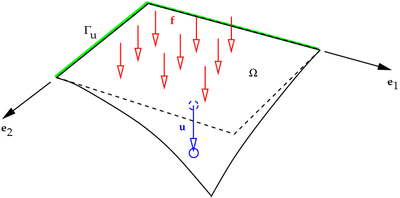Nonlinear finite elements/Steady state heat conduction
< Nonlinear finite elements| |
Subject classification: this is a physics resource . |
Steady state heat conduction
If the problem does not depend on time and the material is isotropic, we get the boundary value problem for steady state heat conduction.
Poisson's equation
If the material is homogeneous the density, heat capacity, and the thermal conductivity are constant. Define the thermal diffusivity as
Then, the boundary value problem becomes
where  is the Laplacian
is the Laplacian
Laplace's equation
Finally, if there is no internal source of heat, the value of  is zero, and we get Laplace's equation.
is zero, and we get Laplace's equation.
The Analogous Membrane Problem
The thin elastic membrane problem is another similar problem. See Figure 1 for the geometry of the membrane.
The membrane is thin and elastic. It is initially planar and occupies
the 2D domain  . It is fixed along part of its boundary
. It is fixed along part of its boundary  .
A transverse force
.
A transverse force  per unit area is applied. The final shape at
equilibrium is nonplanar. The final displacement of a point
per unit area is applied. The final shape at
equilibrium is nonplanar. The final displacement of a point  on the
membrane is
on the
membrane is  . There is no dependence on time.
. There is no dependence on time.
The goal is to find the displacement  at equilibrium.
at equilibrium.
 Figure 1. The membrane problem. |
It turns out that the equations for this problem are the same as those for the heat conduction problem - with the following changes:
- The time derivatives vanish.
- The balance of energy is replaced by the balance of forces.
- The constitutive equation is replaced by a relation that states that the vertical force depends on the displacement gradient (
 ).
).
If the membrane if inhomogeneous, the boundary value problem is:
For a homogeneous membrane, we get
Note that the membrane problem can be formulated in terms of a problem of minimization of potential energy.






